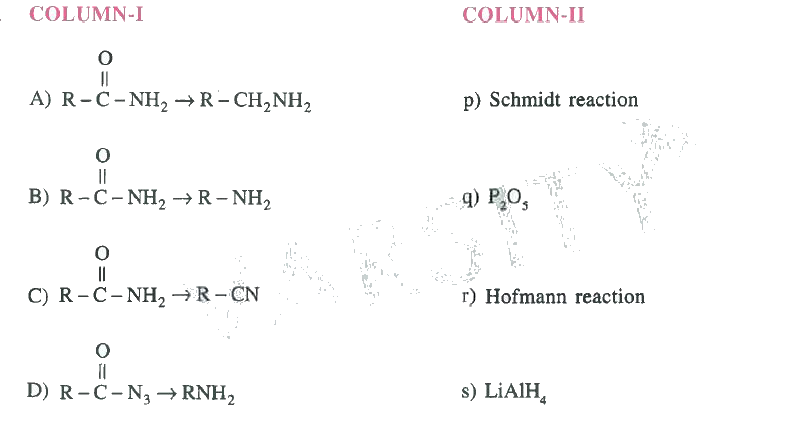
No. of πe−,s in the productSolution in Telugu
The correct Answer is:2
H3−C≡NExcess−−−−−→H3CNyClH3O+H3C−O∣∣C−CH3(πe−s−2)
Topper's Solved these Questions
- BOOK - AAKASH SERIESCHAPTER - AMINES AND AZO COMPOUNDS EXERCISE - PRACTICE SHEET - 6 (Single answer questions)17videos
AMINES AND AZO COMPOUNDS
- BOOK - AAKASH SERIESCHAPTER - AMINES AND AZO COMPOUNDS EXERCISE - PRACTICE SHEET - 6 (More than one correct answer)4videos
AMINES AND AZO COMPOUNDS
- BOOK - AAKASH SERIESCHAPTER - AMINES AND AZO COMPOUNDS EXERCISE - PRACTICE SHEET - 5 (Match the following questions)1videos
AMINES AND AZO COMPOUNDS
- BOOK - AAKASH SERIESCHAPTER - ALKYL AND ARYL HALIDESEXERCISE - OBJECTIVE EXERCISE - 4 (ASSERTION (A) & REASON (R) TYPE QUESTIONS)19videos
ALKYL AND ARYL HALIDES
- BOOK - AAKASH SERIESCHAPTER - AMINES AND DIAZONIUM SLATSEXERCISE - PRACTICE EXERCISE25videos
AMINES AND DIAZONIUM SLATS
Similar Questions
An organic compound (A) on reduction gives a compound (B) which on reaction with CHCl3 and NaOH form (C). The compound (C) on catalytic reduction gives N-methylaniline. The compound (A) is
06:27View SolutionWhich of the following amine(s) after diazotization will form deeply coloured azodye with alkaline solution of β-naphthol :
06:11View SolutionMatch the following columns
 02:12View Solution
02:12View Solution(A) Towards SN2 reaction, order of reactivity is CH3Br>CH3CH2Br>(CH3)2CHBr>(CH3)3CBr.
(R) Greater the stability of carbocation, greater will be its ease of formation from alkyl halide and faster will be the rate of SN1 reaction.01:44View SolutionIUPAC name of (C2H5)3C−NH2 is
03:13View Solution(pi^(e))/(xe)+(e^(pi))/(x-pi)+(pi^(pi)+e^(e))/(x-pi-e)=0 has
05:00View SolutionEvaluate: ∫π0xtanxsecx+tanxdx
07:14View SolutionEvaluate: ∫π/2−π/211+es∈xdx
04:29View SolutionThe value of ∫π/20cosx esinxdx is 1 b. e−1 c. 0 d. −1
10:04View SolutionThe correct option among the following is (a)pi^(e) e^(pi),(c)pi^(e)=e^(pi),(d) none of these
03:31View Solutionint_ (0)^(4 pi) e^(t) (sin^(6) at+cos^(4) at) dtint_ (0)^(pi) e^(t) (sin^(6) at+ cos^(4) at) dta = 2, L = (e^(4 pi) -1)/(e^(pi) -1) (ii) a = 2, L = (e^(4 pi)+ 1)/(e^(pi) +1) (iii) a = 4, L = (e^(4 pi) -1)/(e^(pi) -1) (iv) a = 4, L = (e^(4 pi) +1)/(e^(pi) +1)
09:45View SolutionWhich one is Bigger ?? e^(pi) or (pi)^e
02:56View SolutionWhich of the following statement(s) is/are possible? 2sin^(2)theta=log_(e)pi+log_(pi)e
02:45View SolutionWhich statement (S) is//are correct about the products (E) and (F) ?
06:04View SolutionFrom the following information, calculate the solubility product of silver bromide ?
AgBr(s)+e−⇔Ag(s)+Br−(aq.)E∘=0.07Ag+(aq.)+e−⇔Ag(s)E∘=0.80V04:05View Solution

